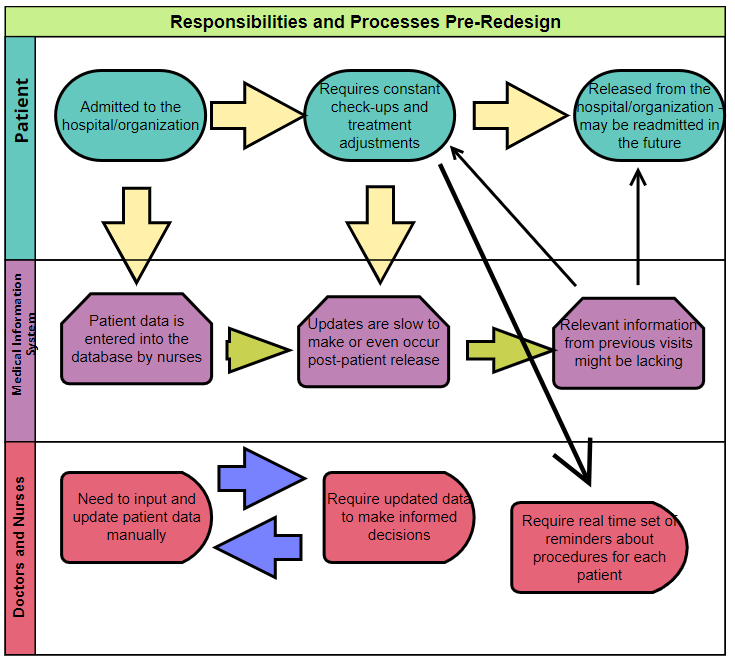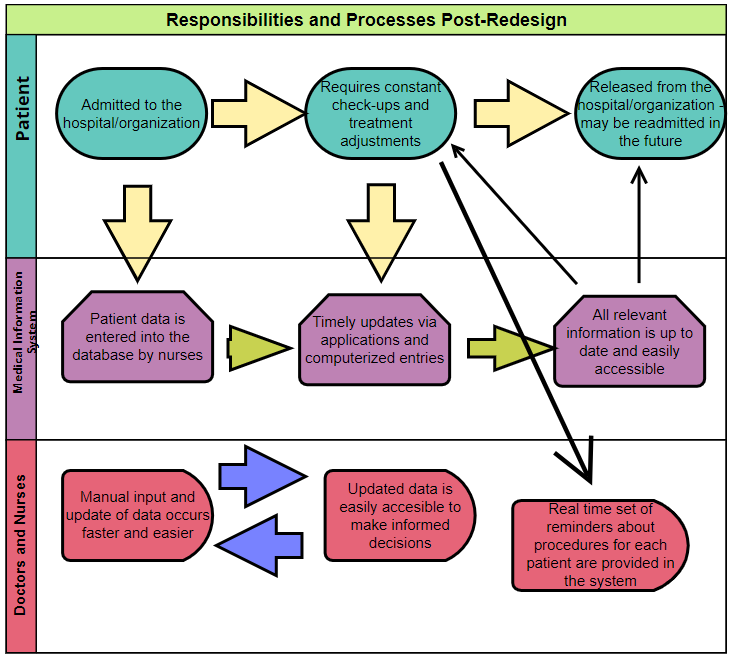Introduction
Nowadays, the number of different methods of diagnosis and treatment in healthcare has increased significantly. The amounts of information about the patients’ health, prescribed medications, laboratory test results, and other necessary indicators, which must be memorized and processed by doctors and nurses, are constantly growing. In addition, data on the patient’s health status is most likely dispersed across several medical institutions providing medical care. All this information necessitates a targeted, well-tailored electronic integration to ensure the best medical performance and patient outcomes. Thus, it becomes crucial to design a more advanced digital medical system to successfully operate the arrays of medical data.
Problem Identification
Patient data is one of the most important aspects of healthcare. However, every time new information is added to the database, its volume increases, and the control of it becomes even harder. Not only storing but retrieving this data when needed is also a problem that hospitals need to solve. Lehne et al. (2019) add that “most of today’s medical data lack interoperability: hidden in isolated databases, incompatible systems and proprietary software, the data are difficult to exchange, analyze, and interpret” (p. 1). Medical information systems have long been an important part of the healthcare system. However, they need to keep being actively improved along with the development of medical and information technologies in order to ensure best quality of patient care.
Figure 1 shows how the responsibilities and stages of the process are currently distributed:

Bottlenecks and Inefficiencies in the Current Process of Managing and Accessing Patient Data
Currently, the process of shifting patient data into digital space is occurring gradually in the U.S. healthcare system. This is due to the fact that the implementation of each element of such system requires strategic planning, comprehensive analysis of risks and benefits, and post-implementation evaluation. Thus, the process is rather drawn-out and tedious for all parties included: from the equipment vendors and IT teams to doctors and nurses. Another inefficiency lies in ensuring the successful adaptation of a medical information system to different requirements of the operating environment. Within this requirement, special attention should be paid to the technology of working with data due to the fact that digital systems process data of different types (numerical, textual, and binary) in almost equal shares. Therefore, the use of any one universal method of working with them in an environment that changes in terms of infrastructure does not give a good result.
Redesign Explanation, Justification, and Importance
The proposed redesign discusses the implementation of specific complementary information technologies into the everyday work of doctors and nurses to help facilitate smoother transition into fully digital systems. For that, several technologies are chosen: smartphone-based applications and computerized clinical reminders and physician entry. Each of the mentioned auxiliary innovations is not only helpful in assisting nurses and doctors in their decision-making and patient management, but also facilitates better patient care through optimization of working processes.
Justification
First of all, smartphone-based clinical-decision support applications would be helpful in managing and accessing patient data more quickly and efficiently. These applications store and allow access to all the necessary information in real time, which allows the healthcare workers to use it in the treatment process. According to Baig et al. (2017), patient administration, billing, health information, making appointments, monitoring of laboratory results, and clinical decision support can be performed via those applications. Another technical means are the computerized clinical reminders which can be used as assistive measures for quality care. This software can be integrated into the existing computer system of the hospital and provide the staff with timely reminders of the medical actions they need to perform on the current patients.
Importance
Implementing these specific technologies would allow the organization to provide high quality patient care, facilitate better health outcomes, and secure its position in the healthcare market sector. Guven (2020) adds that strategic intrapreneurship facilitates innovative approaches as a means to secure the business’ future competitive advantages. An innovative approach with a focus on digitalization to offer better services to the people would provide the organization with an opportunity to achieve a balance between power and responsibility. Moreover, it would directly and effectively stimulate the employees’ positive work attitude by offering them effective means to reduce workload and focus on actual care instead of administrative tasks.
Figure 2 shows how the process occurs in a redesigned system:

Who Would Be Affected by the Redesign and How It Would Be Evaluated
The main staff members who will be directly affected by the redesign are physicians, nurses, and the IT crew of the hospital. Physicians and nurses should be introduced first to the variety of medical technology means for them to choose collectively which specific applications and software they would like to implement into their current work. The IT staff also should be kept informed throughout the selection and implementation process – they must guide it in relation to the organization’s current technical capacities and limitations.
The Process of Evaluation
A DNP nurse can take several steps to evaluate the enhanced system after its final introduction into the organization’s workflow. First of all, a thorough assessment of the system’s accessibility for both patients and staff members must be conducted, with an assessment its overall design and ease of use. Next, after the redesign has been implemented for some time, it should be evaluated for effectivity and performance: if it has achieved set goals, what mistakes and failures have occurred, and could they be prevented.
Specific Evaluation Measure – Real World Test
Ensuring that the redesigned system meets specifically healthcare and technological standards would require a real world test in the modelled environment, with real patient cases and situations. According to Sayles and Kavanaugh-Burke (2021), “examples of situations are admitting Medicare patients, ordering medication, and merging duplicate health records” (p. 26). This test should be done by the picked vendor and evaluated by a DNP nurse, who would also be required to supply the test’s results with data and evidence outlet analysis.
A Strategy to Promote System-Wide Acceptance and Adoption of the Redesign
To promote the adoption of the redesigned digital medical system, a DNP nurse could develop a study based on the results of its’ evaluation and pitch it to other departments and/or healthcare organizations. First of all, the nurse should observe how the system works in their environment, obtaining quantitative and qualitative data of the results of its implementation, for a certain period of time: for example, 6 months. Rørtveit et al. (2020) add that “qualitative methods provide access to a deeper understanding of the participants’ experiences and perceptions of the intervention that goes beyond numbers and statistics (p. 1285). After the research is complete, the nurse should use it to support the adoption of the redesigned system with scientific data and viable real-life results, outlining the positive changes the new technologies brought.
Conclusion
Understanding how to improve digital medical systems is crucial for real life practice, as any healthcare professional is required to use them in their practice environment. Reviewing the existing opportunities for further development of these systems allows one to recognize their potential new features and goals, as well as account for potential issues. Moreover, by looking at the problem from the perspective of patient care, a nurse can learn how to use digital medical systems more efficiently and avoid data losses in the process.
References
Baig, M. M., GholamHosseini, H., Moqeem, A. A., Mirza, F., & Lindén, M. (2017). Clinical decision support systems in hospital care using ubiquitous devices: Current issues and challenges. Health Informatics Journal, 25(3), 1091–1104.
Guven, B. (2020). The integration of strategic management and intrapreneurship: Strategic intrapreneurship from theory to practice. Business and Economics Research Journal, 11(1), 229–245.
Lehne, M., Sass, J., Essenwanger, A., Schepers, J., & Thun, S. (2019). Why Digital Medicine depends on interoperability. Npj Digital Medicine, 2(1).
Rørtveit, K., Saetre Hansen, B., Joa, I., Lode, K., & Severinsson, E. (2020). Qualitative evaluation in nursing interventions—a review of the literature. Nursing Open, 7(5), 1285–1298.
Sayles, N. B., & Kavanaugh-Burke, L. (2021). Introduction to information systems for health information technology. AHIMA Press.